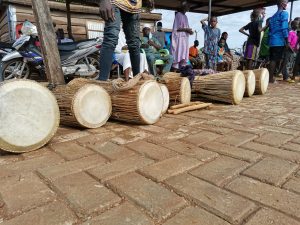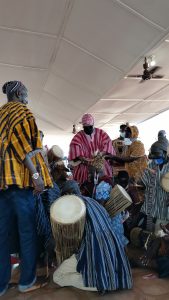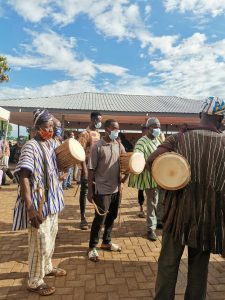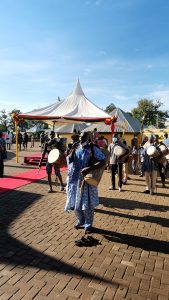The Lunsi: The Dagomba ethnic group in the northern part of Ghana, has some of the most enviable and well-preserved cultural practices, centered around drumming and dancing. Some of these practices date as far back as the 12th century.
Even though some of their practices have seen changes and others have been abandoned entirely, due to the advent of the islamic religion, the Dagbamba have been able to maintain a very significant aspect of their indigenous practices.
Click To Join Our WhatsApp Group
Click To Join Our Telegram Group:
The ability of the Dagomba people to maintain such a sophisticated culture is largely due to the drummers, known as the luŋa( lunga) or lunsi (plural).
Among the Dagbamba,the lunsi are seen as custodians of not just Dagbon history but their culture as well. This is because the lunsi are trained to memorize and maintain a pure line of oral narrations of past events. This has been passed on from generation to generation through a complex system of oral literature.
The Origin Of The Lunsi

” Yani-dabari” – near Diare around the 14th century, after the break down of the Greater-Dagbon kingdom.
Naa Shitɔbu, who left the Greater Dagbon kingdom with the Gbewaa regalia and who considered himself the strongest among the Sons of Naa Gbewaa, due to his large followers, nicknamed himself “Yaa-Naa”, literary meaning, King of Absolute power or strength.
Read More : Aboriginal Dagombas : Before The Advent Of Yananima
After the death of Naa Shitɔbu, his son Naa Nyaɣisi succeeded him.
When Naa Nyaɣisi became king, he took up arms against the minority tribes, in an effort to expand the Dagbon kingdom.
He did this by killing the “Tindamba” ( fetish priests) and installing his sons as chiefs in those communities.
In some instances, he enskinned his uncles and close associates, thereby bringing those areas under his authority.
The Tindaamba were the aboriginal Dagombas, who settled earlier in the present day Dagbon before the Yaanabihi (princes) arrived.
The rage of Naa Nyaɣisi soon spread across the lands of the tindaamba and some of them abandoned their lands and fled, while others went into hiding.
Read More : Naa Gungobili -The destitute Prince of Dagbon Kingdom
So when Naa Nyaɣisi reached a town known as Diyali Lunzoo. A group of men came out of a cave. Apparently, they have been hiding in that cave to allude to the wrath of Naa Nyaɣisi. But when they heard the sound of the cavalry, they were afraid that if they were found, they all be given instant execution, without mercy. And so they decided to avert the situation in a different way.
When Naa Nyaɣisi approached them, the men fell on their knees. In their arms, they held two shells which they hit against each other to produce a soothing rhythm. The oldest among them, who was supposedly their father, sung praises in honor of Naa Nyaɣisi, saying;….

” Nyini n nyɛ tihi ni mɔri lana”
you are the owner of tress and grass
” Nyini n nyɛ Dunialana”
You are the owner of the universe
” Nyin n kuri shɛba, ka gbahiri shɛba”
Oh you, who kill others and apprehend others
” Nyini n nyɛ ti duma”
You are our lord…….
With these words, Naa Nyaɣisi became intoxicated and decided to spare them. He was intrigued at the ingenuity exhibited by them.
He asked their leader who they were and he said ” We are lunsi. My name is Tusua and these are my children. When we heard of you, we decided to hide here and wait for you, so that we could say your praises. This is the only way we can avert your anger”
It is worthy to mention that, the words which Luŋ Tisua used to praise Naa Nyaɣisi have become the praise names of the Yaa-Naa till date.
The Advent of Lunsi : Naa Nyaɣisi Entrusts His Two Sons Under The Care Of Luŋ Tusua
Having granted amnesty to Luzoo Tisua and his family, Naa Nyaɣisi placed two of his children under his care. Luŋ Tusua was expected to teach them their art of singing and playing tunes.
Read More ; Slave Trade And Its Resistance In The Gbewaa States
Biziŋ and Ʒima were siblings. Their mother passed away after giving birth to Ʒima. Due to the absence of their mother, the other wives of Naa Nyaɣisi treated them with disdain. They hardly gave them food. And they starved most of the time, watching their colleagues eat to their fill.
In order to get a slice of the meals, Biziŋ and Ʒima would often beat some broken calabashes, while singing. This was how they entertained the other kids in order to get a piece of every meal.
When Biziŋ became a teenager, He made a musical instrument out of a calabash, covered with an animal skin. And with this, Biziŋ would sit behind his father’s hut and sing about his woes. This was how he drew his fathers attention that he hadn’t eaten.

One day, Naa Nyaɣisi invited him to play his tunes before him and this marked the birth of the popular drum beat, Dakoli N-Nyɛ bia ba, Namlana.
Dakɔli nyɛla bia
O ba nyɛla Naawuni
Paɣ’lan nyɛla kpɛma
O ba nyɛla Naawuni!
ŋun mali ŋun dima
O ba nyɛla Naawuni
ŋun kɔŋ ŋun ʒiya
O ba nyɛla Naawuni
This particular state of Biziŋ and Ʒiba caused so much anxiety to Naa Nyaɣisi and he always prayed for an opportunity to redeem them.
After handing over Biziŋ and Ʒima to Luŋ-Tusua, Naa Nyaɣisi then proceeded to Dipala and killed the tindana there. This was followed by Yuɣimpunkɔligu Tindana
Kasalligbee tindana
Pulimpuŋshɛbili tindana
Kiduhi-ʒiɛɣu tindana
Barikpunatu zuɣu tindana
Namɔɣu tindana
Gaa Tindana
Naa Nyaɣisi then proceeded further to Kumbungu and killed the Tindana there. He then appointed his son, Bimbiɛm as chief of Kumbungu.
At Zuɣu, he appointed his son, Bɛyimwaa as chief.
It is important to mention that, most of the towns in Dagbon got their names and appelations from the names of Naa Nyaɣisi’s children, uncles, and other close associates
For instance, at Kariga, Naa Nyaɣisi appointed his uncle and Son of Naa Gbewaa, Beemoni as chief. This is why Kariga is known as Beemoni Yili.

Other children of Naa Nyaɣisi included:
- Zɔɣulan Garimburi
- Tibuŋlan Lunduu
- Siŋlan laliyɔɣu
- Gbungbaligulan pɔbisiŋmɛma
- Diyalilan Shilinaa
- Nyankpalilan Benyom
- Namlan Zulandi
- Tamaligu Goozabili
- Gbuluŋlan Lukpaa
- Vo-Naa Bambiliye
and may more.
It is also worth mentioning that, the success of Naa Nyaɣisi against the tindamba was a result of his well-structured military. The tindamba lived in smaller clans, and so the Calvary of the invaders overwhelmed them. This made them easy prey for the men on horse’s backs.
Read More: Names of Animals in Dagbani Language
The Advent of Lunsi : Biziŋ Becomes A Luŋa
When Naa Nyaɣisi killed the tindana of Namɔɣu, he left the place vacant. One day, Naa Nyaɣisi sent for his Son Biƶiŋ. Ʒima did not live long to accomplish his father’s wish. He died at an early age.
When Biziŋ arrived, instead of walking like a Prince, he knelt down with his followers and chanted the praise name of Naa Nyaɣisi. Feeling astonished, Naa Nyaɣisi appointed Biziŋ as chief of Namɔɣu.
The oral narration has it that, Even though Luŋ-Tisua started luŋa and mentored Biziŋ, it was Biziŋ who started playing the luŋa, which we have today.
And so all Lunsi trace their descend to Namo-Naa Biziŋ.
The lunsi are therefore considered Yaanabihi. But through Biziŋ, they have become praise singers. Nonetheless, the lunsi are still much recognized and have a befitting seat at the Gbewaa Palace.
Today, the Namo-Naa, who is appointed by the Yaa-Naa is the leader of all the lunsi in Dagbon.
Other lunsi titles include ; Lun-Naa, Sampahi-Naa, Lunzoo and Taha-Naa.
All chiefs in Dagbon, therefore, have their Lun-Naa. Only the Yaa-Naa has a Namo-Naa.
Lunsi Gain Prominence In Dagbon
Even though Naa Nyaɣisi bestowed upon his son, Biziŋ the title of Namo-Naa, the lunsi were actually not assimilated into the heart of Dagboŋ, nor did they have a place at the Gbewaa palace until Naa Luro
” wundabili ku baŋ nini, naɣila tuma ni” ascended the Gbewaa Skin.
Naa Luro was the Son of Naa Zoligu, who became Yaa-Naa around 1557. He was the 13th Yaa-Naa of Dagbon, right from Shitɔbu. He succeeded Naa Dariʒiɛɣu (1543- 1554).

Naa Dariʒiɛɣu died at a village known as Kalɔŋ, alongside his entourage.
Kalɔŋ is what is known as Daboya today. Naa Dariʒiɛɣu had gone to visit his mother at Daboya when he was ambushed by a Wangara warrior by the name Ibrahim Sumaila. Naa Dariʒiɛɣu was killed alongside his wives and children.
Ibrahim Sumaila, was a Mande warrior Prince, who migrated to present-day Ghana amidst a family dispute. He settled at Daboya in middle of A Dagbon – Gonja struggle for trade control.
Having conquered the Gonjaland, the Gonjas submitted to his leadership.
READ MORE : Dagbani Proverbs – Dagbɔŋ ŋaha
The Mande Warrior, Ibrahim Sumaila laid ambush for the entourage, with the notion that Naa Dariʒiɛɣu was coming to attack him at Kalɔŋ.
After Naa Dariʒiɛɣu was killed, Ibrahim Sumaila having realized that the martyred were unarmed and that he had just killed the king of Dagbon, fled towards South to a village now known as Kpembe.
So when Naa Luro took over the Skin of Dagbon, he vowed to visit kalɔŋ for vengeance for the murder of Naa Dariʒiɛɣu when the time is rife.
One day, angered by the words of a jealous wife, Naa Luro went to Kalɔŋ against the advice of Yani-Kpamba.
But by the time Naa Luro went to Kalɔŋ, Ibrahim Sumaila was far away in Kpembe and so Naa Luro had an encounter with a Gonja Chief known to the Dagbon people as ” kalɔgsi dojia”.
Having attained victory, Naa Luro was so excited that, he called his best horse rider, ” Wɔri-nachim Zom ʒi biɛri” to bring to him, a praise singer, who’ll sing his praise name as he journeys back to Dagboŋ.
” Wɔri-nachim Zom ʒi biɛri” set off and within no time, he came back with a praise singer with a flute in his hand.
But when he started whistling, Naa Luro stopped him and told him. You are a praise singer fit for Mondays and Friday ceremonies. You are not a praise singer for battles.
And with this, Naa Luro sent him away
“Wɔri-nachim Zom ʒi biɛri” then brought forth a Piper. The Piper too was sent away by Naa Luro, for the same reason.
“Wɔri-nachim Zom ʒi biɛri” yet again, returned with the “Batandana” . The Batandana plays an instrument known as ” Bindili”. The bindili is made with a big calabash, covered with a skin of an animal to look like a drum.
But when the Batandana started playing, he was mute. He only played without uttering a word.
Naa Luro feeling disappointed, sent the Batandana too away, saying ” This one is fit for ceremonies and not battles”.
At this point, Naa Luro was infuriated by the failure of “Wɔri-nachim Zom ʒi biɛri” to get him a praise singer, fit for battles. He threatened to behead “Wɔri-nachim Zom ʒi biɛri” if he returns without a befitting praise singer.
Frightened, “Wɔri-nachim Zom ʒi biɛri” wept as he raced to nowhere, in search of a praise singer. He was almost certain that his days on earth had ended. As he raced down to nowhere, he met a man known as ” Tikub-Naa”.
Having narrated his ordeal to him, Tikub-Naa asked “Wɔri-nachim Zom ʒi biɛri” to give him money and cola before he assist him. This ” Wɔri-nachim Zom ʒi biɛri” oblidged.
Tikub-Naa then raised his hand, pointing towards Diare. ” Go to Zooshiri yili. There you’ll find the son of Biziŋ. His name is Lunʒiɛɣu. I’m sure he’ll save your life from this wicked king ”
And in no time, “Wɔri-nachim Zom ʒi biɛri” was at the house of Lun-ʒiɛɣu. When lun-ʒiɛɣu heard that Naa Luro was the one summoning him, he was terrified.
And so he quickly sent his son to fetch his siblings; kpachi Yɛnzoli
Luŋ Yɛmo Dapiɛliga
Luŋ naɣ’nyili kɔŋ sabili
Luŋzoo muɣ’yili
Luŋ ŋmɛ bo viri
Luŋ ŋmɛ Tisua
Luŋ ŋmɛ digando
“Tell them to hurry up! The king who refused to go to battle in the dry season but chose the wet season has called on us”, he said.
Lun-ʒiɛɣu and his siblings arrived at Nam-ka-biɛm ni and knelt before Naa Luro. But when Naa Luro greeted them, instead of responding, they beat their drums.
Before Naa Luro could utter another word, Lun-ʒiɛɣu started appelating Naa Luro.
” Na’dabili ŋun lee che tɔbu wuuni yibu, yiri shiɛɣuni”
To with, ” The king who abandons the dry season and wages war in the wet season”
Lun-ʒiɛɣu then went on to mention the names of all the towns Naa Luro has occupied before his ascension to the Gbewaa skin. Historically, according to oral narration, Naa Luro is accredited as the King who has claimed more chieftaincy titles than any known King in Dagbon. It is said that Naa Luro alone occupied 40 villages as chief before he reached the Gbewaa skin as Yaa-Naa.
When Naa Luro heard the praises of Lun-ʒiɛɣu, he became hyperexcited. He told “Wɔri-nachim Zom ʒi biɛri” that indeed, he has brought forth a battle praise singer this time around and for that, he is free to live.
He then asked Lun-ʒiɛɣu to pause for the proper exchange of pleasantries. Naa Luro greeted them again and again, they beat their drums instead of responding. This has become a tradition among the lunsi . At the Yaa-Naa’s palace, when the lunsi are greeted, they respond by hitting their drums.
Naa Luro ordered that a Ram be killed to prepare a delicacy for them.
This particular event marked the birth of the popular drum beat known as “Sambani Luŋa”.
The Sambani luŋa is a drumbeat that recollects past Chiefs of Dagbon. The drummer starts from a past king, down in succession, until it gets to the current King.
Usually, when playing the Sambani Luŋa, the drummers do not go beyond Naa Luro. And when a Drummer finishes with Samban Luŋa, the Yaa-Naa kills an animal for them; mostly a sheep.
However, if there are certain events and kings, who the drummer avoids in his narration because of its repercussions.
And so, when Naa Luro prepared to journey back to Dagbon, Lun-ʒiɛɣu and his sibling;the lunsi, accompanied him with the Bangumaŋa ( Bangumanga) tune.
” Man dii yɛli, ka nyin bi lan nya?”
” Bɛ pan bo ma bo n je”.
The Bangumaŋa tune is played after a victory in war or when a king dies.
But whenever a luŋa plays the Sambani luŋa and gets to Naa Luro, he accompanies it with the “Bangumaŋa”.
For it was the victory of Naa Luro at Kalɔŋ which initiated the lunsi into the heart of Dagbon.
Indeed, today, the lunsi form an inalienable part of Dagbon culture and tradition.
And they and the Yaanabihi (princes) are of the same lineage but through Biziŋ; son of Naa Nyaɣisi, the lunsi have become women, singing the praise names of kings, chiefs and ordinary men.







10 Comments
Comments are closed.